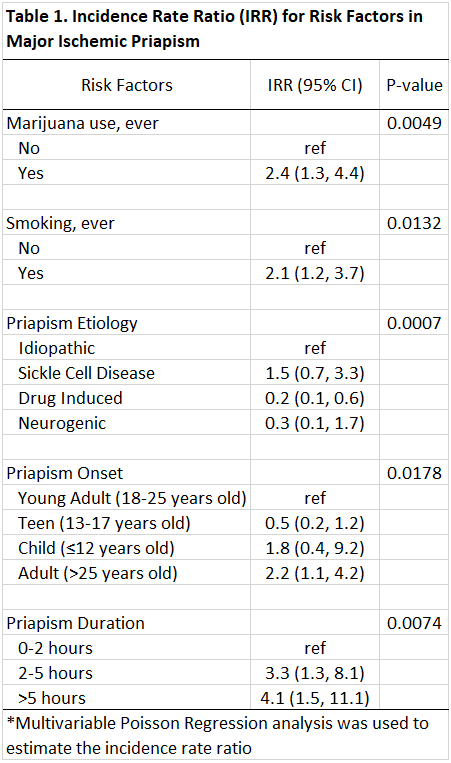Back
Poster, Podium & Video Sessions
Podium
PD47: Sexual Function/Dysfunction: Evaluation II
PD47-12: Predicting Major Ischemic Priapism: A Novel Dynamic Nomogram Based on Recurrent Ischemic Priapism Risk Factors
Sunday, May 15, 2022
2:50 PM – 3:00 PM
Location: Room 245
Laurence Hou*, Hackensack, NJ, Yuezhou Jing, Bruce Trock, Arthur Burnett, Baltimore, MD
- LH
Laurence Tang Hou, MD, BA
Resident Physician
Podium Presenter(s)
Introduction: Recurrent ischemic priapism (RIP) is a form of ischemic priapism that manifests as repetitive undesired erections with intervening periods of detumescence. RIP presents with varying degrees of severity that may impact treatment efficacy and predict major ischemic priapism (MIP). We sought to describe MIP risk factors and create a prognostic model for future MIP events.
Methods: We performed a retrospective chart review of RIP patients who were seen at a single academic institution from May 2006 to November 2020. We defined RIP as having at least two priapism events over time. Data extracted included demographics, priapism characteristics, comorbidities, follow-up time, and presence of MIP events (erection =6 hours). We performed univariable and multivariable Poisson regression analysis to identify risk factors for developing MIP events. Index variables were chosen based on the most common RIP presentations. Clinically significant factors determined from multivariable Poisson regression analysis were used to create a dynamic nomogram using the R package, DynNom.
Results: A total of 113 patients diagnosed with RIP were identified. The median age was 29 years (interquartile range [IQR] 22, 41) and median follow-up was 3.0 person-years (IQR 0.5, 7.3). Priapism etiology was idiopathic in 52 patients (46%), sickle cell disease (SCD) in 44 (39%), drug induced in 14 (12%), and neurogenic in 3 (3%). There were 225 recorded MIP events over 557.5 patient-years of follow-up. Multivariable Poisson regression analysis showed that marijuana use, smoking, SCD etiology, bimodal age ranges of onset, and increasing RIP duration were associated with increased incidence rate ratio of MIP (Table 1). Priapism frequency was not a significant predictor of MIP (p=0.52). Patient risk factors can be put in the nomogram to predict the number of MIP events expected over one year (https://jerry-jing.shinyapps.io/MIP-DynNomapp/).
Conclusions: Our study, which conceivably applies the largest RIP database to date, shows that several risk factors contribute to increased MIP events. The dynamic nomogram uses RIP severity and other factors to quantify MIP risk, which may assist clinicians in managing priapism. Further validation of the nomogram is planned.
Source of Funding: None.

Methods: We performed a retrospective chart review of RIP patients who were seen at a single academic institution from May 2006 to November 2020. We defined RIP as having at least two priapism events over time. Data extracted included demographics, priapism characteristics, comorbidities, follow-up time, and presence of MIP events (erection =6 hours). We performed univariable and multivariable Poisson regression analysis to identify risk factors for developing MIP events. Index variables were chosen based on the most common RIP presentations. Clinically significant factors determined from multivariable Poisson regression analysis were used to create a dynamic nomogram using the R package, DynNom.
Results: A total of 113 patients diagnosed with RIP were identified. The median age was 29 years (interquartile range [IQR] 22, 41) and median follow-up was 3.0 person-years (IQR 0.5, 7.3). Priapism etiology was idiopathic in 52 patients (46%), sickle cell disease (SCD) in 44 (39%), drug induced in 14 (12%), and neurogenic in 3 (3%). There were 225 recorded MIP events over 557.5 patient-years of follow-up. Multivariable Poisson regression analysis showed that marijuana use, smoking, SCD etiology, bimodal age ranges of onset, and increasing RIP duration were associated with increased incidence rate ratio of MIP (Table 1). Priapism frequency was not a significant predictor of MIP (p=0.52). Patient risk factors can be put in the nomogram to predict the number of MIP events expected over one year (https://jerry-jing.shinyapps.io/MIP-DynNomapp/).
Conclusions: Our study, which conceivably applies the largest RIP database to date, shows that several risk factors contribute to increased MIP events. The dynamic nomogram uses RIP severity and other factors to quantify MIP risk, which may assist clinicians in managing priapism. Further validation of the nomogram is planned.
Source of Funding: None.


.jpg)
.jpg)